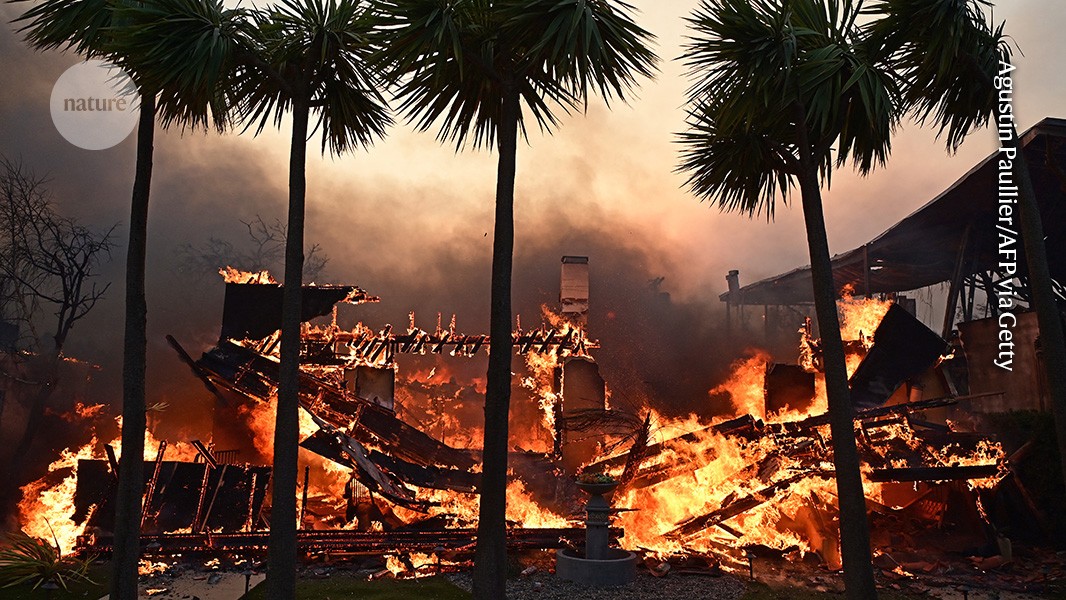Why fires spread quickly in modern cities ― and how to slow them

Research also suggests how to make homes more resilient in the aftermath of California’s deadly blazes

A home is destroyed in in the Palisades fire in California.Credit: Agustin Paullier/AFP via Getty
The fires that have incinerated large swathes of southern California are among the deadliest and most destructive in the state’s history. Scientists say that the blazes have another grim distinction: they are terrifying examples of urban firestorms, which are fundamentally different from the wilderness fires that tear through forests and shrublands.
In fires that burn densely populated areas, buildings themselves become fuel. Neighbourhoods in the Los Angeles area went up in smoke because house after house caught fire, driving the flames’ spread.
“This was an urban conflagration and not just a wildfire event,” says Ann Jeffers, a structural engineer and fire expert at the University of Michigan in Ann Arbor. The fires have killed at least 24 people and destroyed more than 12,000 structures.
Researchers say that such urban fires are likely to become more common thanks to population trends and climate change. Scientists are now learning about how exactly urban fires spread and what can be done to prevent them. “There are so many minute physics details here that are important,” says Michael Gollner, a mechanical engineer and fire expert at the University of California, Berkeley. Those details can be crucial in helping to reduce the fire risk of vulnerable communities ― including Los Angeles as it rebuilds.
Weather whiplash
The factors that drove the intensity of the Los Angeles wildfires include the density of homes in steep terrain and powerful winds that fanned the flames. Another factor was what a recent paper1 calls “hydroclimate whiplash”, an abrupt switch between very wet and very dry conditions that is likely to occur more frequently as Earth warms. The Los Angeles area received abnormally large amounts of rain in 2023 and early 2024, promoting plant growth. But less than 1 millimetre has fallen since 1 July, and all that brush and grass dried into tinder.

An aerial view of homes destroyed by the Palisades fire.Credit: Mario Tama/Getty
These meteorological factors are interacting with human decisions. Around the world, more people are moving into the ‘wildland-urban interface,’ where cities meet natural landscapes2. Fires that ignite at these interfaces can spread into purely urban areas with devastating results, as in Lahaina, Hawaii, in 2023 and Valparaíso, Chile, in 2024. As population in the boundary zones grows, fires that start there are more likely to migrate into areas that are unequivocally urban, researchers say.
Fire behaviour
As the conditions for urban fires became more common, researchers are beginning to understand how such blazes behave.
One research frontier is understanding how radiant heat from a building that is on fire can ignite buildings standing nearby. At the Tampa, Florida-based Insurance Institute for Business & Home Safety, researchers build test homes and shower them with embers and walls of flame to quantify the conditions under which a building will burn. That includes how far apart structures need to be spaced to reduce the chances of one igniting the next in a domino-style impact; early tests, for instance, concluded that storage sheds should be a minimum of 6 metres away from a main structure.
Enjoying our latest content?
Login or create an account to continue
- Access the most recent journalism from Nature's award-winning team
- Explore the latest features & opinion covering groundbreaking research
or
Sign in or create an accountdoi: https://doi.org/10.1038/d41586-025-00141-z
This story originally appeared on: Nature - Author:Alexandra Witze


















